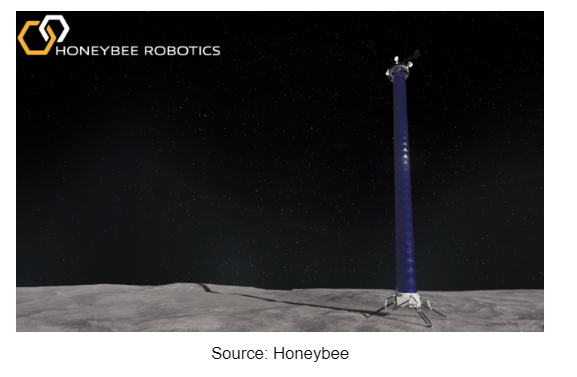Building a network of towers on the moon is the key to NASA’s goal of establishing a permanent human presence on the moon as part of the Artemis program, according to Phys.Org. And those towers would need to be multipurpose.
Honeybee’s LUNARSABER combines solar power, power storage and transfer, communications, mesh network, position, navigation, timing, and surveillance into a 328-foot deployable tower. The LUNARSABER was developed by Honeybee Robotics for the Defense Advanced Research Project’s (DARPA) 10-Year Lunar Architecture Capability Study (LunA-10).
“The moon is a very harsh environment. It is a near vacuum and has huge temperature swings, with a large varying topography,” said Vishnu Sanigepalli, Principal Investigator, LUNARSABER, DARPA’s LunA-10 Program. “There are places near the South Pole where light has not reached it for nearly 2 billion years. The lack of basic utility infrastructure makes it very challenging to explore the moon right now.”
Building each tower is also no cinch. Since a 328-foot tower cannot be flown on a rocket and landed on the moon, the LUNARSABER must actually build itself after it is landed, according to Phys.Org, using Honeybee’s Deployable Interlocking Actuated Bands for Linear Operations (DIABLO) system.
“DIABLO takes flat sheet metal bands, interlocking them into a strong cylindrical tube,” Sanigepalli said. “It is compact when stowed, and can self-deploy from the base to construct tall towers.” The result is a structure that can support one metric ton of payloads on its masthead.
The importance of the towers, according to Sanigepalli, is surprisingly down to earth. “The really great part about having these tall towers is having a long line of sight on the surface,” he said. “This elevated line of sight offers significant advantages for payloads on the masthead, such as cameras, communication systems and wireless power transmission.” At a height of 328 feet, the LUNARSABER will have a coverage area of up to 23 miles in diameter.
LUNARSABER’s lights can be used to illuminate deep craters to provide visibility. If the rover is unreachable, using its localized network, the LUNARSABER’s cameras and LIDAR can be used to reestablish the connection. Additionally, the LUNARSABER has the ability to wirelessly recharge the rover using its power beaming system on top of the masthead.
“This functionality minimizes mission risks, increasing payloads and chances to survive the harshest lunar conditions,” Sanigebelli said. “When established as a grid of towers, this infrastructure achieves a whole new level of functionality and efficiency.”
By J. Sharpe Smith, Inside Towers Technology Editor





Reader Interactions